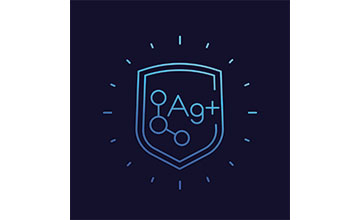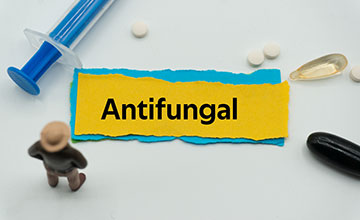Silver-Based Antifungal
Silver has a long-standing reputation in antimicrobial technologies for its impressive ability to fight off a wide variety of microorganisms. Its effectiveness, especially in ionic and nanoparticle forms, makes it a strong defence against common issues like fungi and algae that many industries face.
Silver Ion (Ag+)
Silver ions, denoted as Ag+, represent the charged form of silver and serve as the core of its antimicrobial properties. These ions are released from silver compounds and exert their effect by disrupting key cellular processes in microorganisms. In fungi, silver ions can bind to proteins and nucleic acids, interfering with cell respiration and reproduction. This results in the inhibition of fungal growth and, in many cases, the eventual death of the microorganism. The versatile nature of silver ions makes them suitable for use in coatings, textiles, and a variety of industrial and healthcare applications.
Unlike traditional antifungal agents that target specific pathways, silver ions work across a broad spectrum of microorganisms, making them highly effective in preventing fungal growth. Moreover, their ability to disrupt microbial membranes means that they are fungicidal, actively killing fungal cells rather than merely inhibiting their growth. This makes silver ions a preferred choice in environments where consistent antimicrobial activity is needed.

Nano Silver
Nano silver, consisting of silver particles at the nanometre scale, enhances the efficacy of silver’s antifungal properties by increasing surface area and interaction with microbial cells. Nano silver particles are capable of penetrating fungal cell membranes more efficiently than larger particles, making them extremely effective in attacking fungi at a cellular level. This is particularly important in combating resistant strains of fungi that have developed tolerance to other antifungal treatments.
The use of nano silver in coatings and textiles creates long-lasting antimicrobial surfaces. These surfaces can release silver ions over time, ensuring continued protection against fungal and algal growth. Nano silver’s minute size allows it to integrate seamlessly into a wide range of materials without compromising structural integrity or appearance. Whether used in paints, plastics, or fabrics, nano silver provides an invisible yet powerful line of defence against fungal contamination.
Micro Silver
Micro silver is another form of silver-based antimicrobial technology that, while larger than nano silver, still offers significant antifungal properties. The larger particle size of micro silver allows it to remain on surfaces longer, slowly releasing silver ions to maintain long-term protection. This makes micro silver particularly suitable for applications where prolonged antimicrobial action is desired, such as in medical devices, hygiene products, and surfaces that require sustained fungicidal activity.
Despite its larger particle size, micro silver retains the same core mechanism of action as nano silver and silver ions. It disrupts fungal cell membranes, impeding the organism's ability to function and reproduce. The slow-release nature of micro silver also makes it an excellent choice for use in environments where consistent antimicrobial action is required over extended periods of time, such as in healthcare and sanitation.

Fungicidal
Fungicidal agents are substances that actively kill fungi rather than simply preventing their growth. Silver-based products, especially those containing silver ions or nano silver, are highly fungicidal. When applied to surfaces or integrated into materials, these agents create an environment that is inhospitable to fungal growth by directly targeting the cellular structures of the fungus.
The fungicidal properties of silver have been extensively studied and documented. Silver ions, in particular, can inhibit the growth of various fungal species, including those responsible for mold, mildew, and other unwanted biological growth. This makes silver an essential component in products designed to prevent fungal contamination in industries ranging from construction to healthcare.
Silver Shield Technology
Silver shield technology leverages the antimicrobial properties of silver to create a protective barrier on surfaces. This technology is designed to release silver ions over time, ensuring that surfaces remain free from fungal and microbial growth for extended periods. Silver shield coatings are particularly effective in environments prone to fungal contamination, such as moist or humid conditions where fungi thrive.
Silver shield is not only used for its antifungal properties but also for its broad-spectrum antimicrobial effects, making it a popular choice in healthcare settings, food processing industries, and public spaces. The slow-release mechanism of silver shield ensures that fungi, algae, and bacteria are continuously targeted, providing ongoing protection against contamination.

Anti-Algae Capabilities
In addition to its antifungal properties, silver also demonstrates effectiveness against algae. Algal growth is a common problem in environments exposed to water and moisture, such as industrial cooling systems, swimming pools, and even building exteriors. Nano silver and silver ions are effective in inhibiting algae growth by disrupting the photosynthetic processes of these organisms, preventing their proliferation.
Anti-algae treatments incorporating silver are often used in paints and coatings designed for outdoor use, where algae can form unsightly and damaging growths on surfaces. Silver’s dual action against both fungi and algae make it an indispensable component in maintaining cleanliness and preventing biological growth in various environments.
Silvadur: Advanced Antimicrobial Protection
Silvadur is an advanced antimicrobial technology that incorporates silver ions into fabrics and other materials, providing long-lasting protection against fungi, bacteria, and algae. This technology is widely used in textiles, particularly in industries where hygiene is paramount, such as healthcare, hospitality, and activewear.
The key to Silvadur’s effectiveness lies in its ability to continuously release silver ions when microbial contamination is detected. This ensures that the material remains protected over extended periods, even after multiple uses or washes. Silvadur’s integration of silver ions into fibers makes it particularly useful for creating antifungal fabrics and surfaces that are both safe and durable.
IPNR Endura’s silver-based technologies offers a highly effective solution for combating fungal and algal growth across various industries. As industries continue to seek more efficient and sustainable ways to maintain cleanliness and hygiene, silver-based antifungal technologies will remain at the forefront of antimicrobial innovation.

